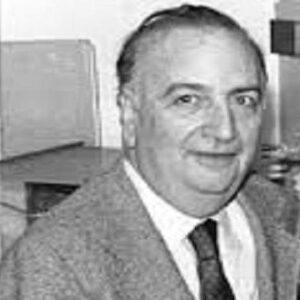Baruj Benacerraf was an American immunologist of Venezuelan descent who shared the 1980 Nobel Prize in Physiology or Medicine. The identification of gene groupings known as “major histocompatibility complexes” and the understanding of their ability to regulate immune responses constitutes his most significant contribution. Even though he was born into a family with a business background, he pursued a career in science, graduating from Columbia University with a Bachelor of Science and the Medical College of Virginia with a Doctor of Medicine. After a year of service in the United States Army, he began his profession as a researcher. As a researcher, he was able to study on diverse topics, including the structure of antibodies, tumor-specific immunity, immunochemistry, immunological complex illnesses, etc. He collaborated with numerous prominent scientists, including William Paul, Victor Nussenzweig, Gerald Edelman, and Zoltan Ovary. The 1980 Nobel Prize in Physiology or Medicine was shared by him, immunologist Jean Dausset, and geneticist George D. Snell.
Childhood & Adolescence
Baruj Benacerraf was born in Caracas, Venezuela, on October 29, 1920. His father was a Spanish Moroccan businessman and his mother was from French Algeria. Paul Joseph Salomon Benacerraf, his brother, went up to become a prominent philosopher.
In 1925, he and his family moved from Venezuela to Paris. His primary and secondary studies were completed in French.
In 1939, upon the outbreak of World War II, he and his family relocated back to Venezuela. 1940 he came to New York, United States to pursue higher education.
In 1942, he graduated from Columbia University’s School of General Studies with a Bachelor of Science degree. Later, he graduated with a Doctor of Medicine degree from the Medical College of Virginia.
Baruj Benacerraf’s Career
Baruj Benacerraf completed his medical internship at the Queens General Hospital in New York City after graduating, and then served in the United States Army from 1946 to 1948.
After completing his military service, he joined the College of Physicians and Surgeons at Columbia University as a researcher. During this era, he gained an understanding of immunochemistry and fundamental immunology.
In 1949, he moved to Paris with his wife and daughter, and afterward obtained a position in the laboratory of Bernard Halpern at the Broussais Hospital. He conducted research on the function of reticuloendothelial cells (RES) in relation to immunity and devised methods for studying the RES’s ability to clear the blood of particles.
In 1956, he went to the United States, where he concentrated on immune complex illnesses, cellular hypersensitivity, anaphylactic hypersensitivity, the structure of antibodies, and tumor-știinștiicștiinștiinștiiștiiștiiștiiștiiștiiștiiștiiștiiștiiștiiștiiștii He collaborated with notable scientists, such as immunologists Robert McCluskey, Philip Gell, Lloyd J. Old, Zoltan Ovary, and biologist Gerald Edelman.
During this time, he also controlled a New York bank inherited from his father: the Colonial Trust Company. However, he left his employment at the bank in order to dedicate more time to science.
In addition, he began his study in immunogenetics, which entailed the finding of genetically determined cell structures that regulate immune responses. As per subsequent studies in this field in the following years, researchers have identified more than 30 genes in a gene complex called the major histocompatibility complex, which regulates immune reactions.
In 1968, he became Director of the Laboratory of Immunology at the National Institute of Allergy and Infectious Disease. Here, he had the opportunity to undertake immunogenetics research.
Two years later, in 1970, he obtained a job at the Department of Pathology at Harvard Medical School. Beginning in 1980, he also served as president of the Dana-Farber Cancer Institute in Boston, which was connected with Harvard.
He retired in 1995 but continued to serve on the Dana-Farber Boards. In his career, he had written roughly 300 papers. His writings include ‘Textbook of Immunology’ (1979) co-authored with Emil R. Unanue, ‘Son of the Angel’ (1990), ‘From Caracas to Stockholm: A Life in Medical Science’ (1998), and ‘Hybrid 5’ (2000). (2003).
His Significant Works
Baruj Benacerraf was an immunologist who studied how the human immune system functions. His most notable contribution was the identification of genes that regulate immune responses and the role of genes in autoimmune disorders.
Awards and Accomplishments
In 1974, he was awarded the Rabbi Shai Shacknai Prize in Immunology and Cancer Research by Hebrew University in Jerusalem.
Helen Hay Whitney Foundation awarded him the T. Duckett Jones Memorial Award in 1976.
The 1980 Nobel Prize in Physiology or Medicine was shared by Baruj Benacerraf, Jean Dausset, and George Davis Snell. The trio got the award “for their discoveries relating genetically determined cell surface features that influence immune reactivity.”
He was awarded the National Medal of Science in 1990.
In 1996, he earned the Gold-Headed Cane Award from the American Society for Investigative Pathology. He got the Charles A. Dana Award the same year.
He was awarded the AAI Excellence in Mentoring Award in 2001.
He was a member of the American Academy of Arts and Sciences, The Institute of Medicine, and The National Academy of Sciences.
Personal History and Legacies
1943 saw the marriage of Baruj Benacerraf to Annette Dreyfus, and the pair had a daughter named Beryl Rica Benacerraf. Annette, his wife, passed away in June 2011.
He died of pneumonia on August 2, 2011, at the age of 90 in Jamaica Plain, Massachusetts.
Estimated Net worth
Baruj is one of the wealthiest and most well-known physiologists in the world. According to our investigation, Wikipedia, Forbes, and Business Insider, Baruj Benacerraf has an estimated net worth of $1.5 million.


